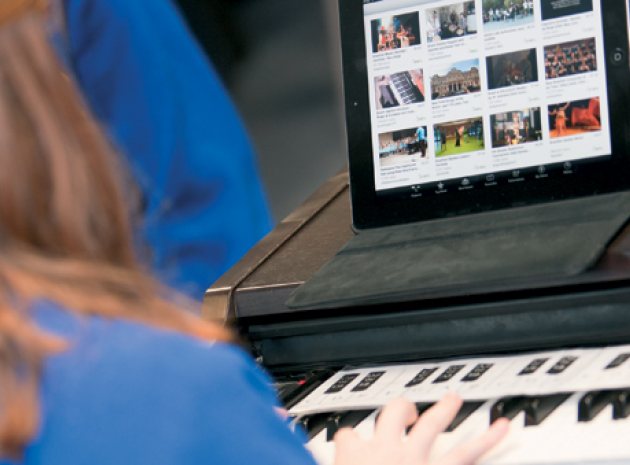The Ofsted report ‘Music in schools: wider still, and wider’ (paying homage to ‘Land of Hope and Glory’, of course), drew attention to a great disparity in the success of music teaching in schools. England has long been considered a leader in music education, but inspections revealed that while some schools were bastions of good practice, too many failed to provide satisfactory music provision, leading to significant barriers to pupils’ musical progression.
Although many students may be interested in listening and playing music outside of school, have a favourite artist, and attend concerts and gigs, music education in school has often not reflected the diversity of children’s musical tastes and interests. Too much theory and not enough opportunities for practical music making was one of the key criticisms of the 2012 Ofsted report into music education. Providing students with the chance to produce their own music is one of the most effective ways of improving their enjoyment of the subject, and ultimately will enhance their progression.
The Glee effect
The popularity of US shows such as Glee has certainly helped captivate the imagination of young people, introducing them to contemporary versions of classic songs and offering up alternative arrangements of current chart hits. Part of the success of Glee has to be attributed to the fact that it is jam-packed with songs that young people know and feel comfortable performing. Introducing more modern genres of music to the classroom such as hip hop, rock and rap shouldn’t represent a dumbing-down of music education, therefore, but rather a way of making music more inclusive for children and young people from all backgrounds.
Post-war British music has been globally successful and influential; artists from the Beatles and the Rolling Stones to Oasis, Dizzee Rascal and Amy Winehouse have all been celebrated in the charts and have helped shape the cultural landscape of the Western world from the sixties onwards, affecting its politics and sociology. However, instead of highlighting these developments, many schools have continued to focus on classical and traditional music. This is starting to change, however, and when it happens, it’s a revolution that puts technology at the heart of many dynamic music lessons.
The rise of classroom ICT means it is increasingly possible to incorporate modern music into a school’s curriculum, and to challenge traditional approaches to music teaching and learning. According to the Ofsted report, use of music technology was inadequate or non-existent in over a third of secondary schools inspected. However, while there is some work to do in training educators in the application and benefits of music technology, many schools are already witnessing the positive impact of utilising ICT devices, software and online resources that enable students to develop their instrumental, musicianship and music creation skills.
Beverly Harrison, a music teacher at Alder Grange High School in Rawtenstall, Lancashire has embraced the use of ICT in music lessons to great effect. Tapping into ‘The Hip Hop Coach’, an online resource, she has brought contemporary music into her lessons to engage her students. “Pupils are motivated to participate in performances that sound authentic yet are achievable,” she comments, “and it’s a great tool for setting relevant practical homework”.
It is important that technology is not in a music lesson for the sake of it but rather to support clear learning objectives and add value and creativity to the teaching process; essentially it should be used to strengthen students’ listening, performing and composing abilities. A teacher with access to an online library of modern music styles such as rap, grime, hip hop and rock can reach out to children in a less traditional way, still focusing on composition, lyrics or cadence but using tools – music, software and hardware – that are instantly familiar to young people. ICT can also allow students to record their own compositions for comparison and evaluation. Online resources based on gaming technology are welcomed by students, and also allow them to direct their own learning and teach themselves valuable new skills.
Now, that’s what I call…
Introducing contemporary music to the classroom alongside classical and traditional examples, with support from technology or other means, is not only integral in improving pupils’ musical acumen and ability – there are also a number of cross-curricular benefits. Some schools have turned to popular music genres such as hip hop in order to teach traditional poetry from the likes of Williams Blake and Wordsworth, for example. Students realise the similarities that exist between the two artistic disciplines when prompted by their teacher, and then many are interested in learning and writing lyrics themselves. Raps can be on any topic, ticking off literacy, music and any other subject. It is possible, therefore, with the correct approach, to build on what children already enjoy doing and adapt it to a subject they previously felt little bond with.
The potential goes further, too. Using contemporary music is not simply about improving students’ aptitudes in the creative subjects – it can also teach them confidence and analytical and communication skills, which are valuable in any academic discipline. Motivating students to share ideas, think outside the box and to exercise independent thought are all skills that can be gained from a fresh approach to music education and can ignite pupils’ thirst to learn in general. The teachers may not relish certain contemporary artists, but if it is music that pupils are passionate about, educators will soon start to notice the enthusiasm levels rise.
There is no ‘one size fits all’ solution for how music should be taught and no one would argue that ICT should be the sole method of delivery for teachers. Instruments and people are simply too important. However, if we’re talking about reaching students and introducing them to concepts that provide a solid foundation for further musical exploration, then it’s undeniably important. Given how much it permeates life beyond the classroom for pupils, it makes sense to use it as a tool to reach students whose passion for music often falls toward Tiny Tempah rather than Tchaikovsky.
Young people can surprise even the most cynical of adults with their creativity; channeling this into music by using formats that are instantly familiar, and songs that are the digital generation’s choice of soundtrack, could be one of the most transformational changes a music teacher can make.
The music business…
Over 130,000 people in the UK are employed actively in the making, performing, recording and distributing of music – and together, they annually contribute nearly £5bns to the economy.
About the author
Mark Burke is digital partnerships director at Charanga (charanga.com). While known today in a technology capacity, mark worked as a professional musician and teacher for 15 years before founding charanga in 1996. As a musician mark studied at the royal college of music and performed across the UK, Japan, US and Europe in a career that also included solo performances on radio 3 and classic fm. 500 concerts for live music now!, performing in mahler’s 7th and knussen’s 3rd symphonies and schoenberg’s serenade represent some personal musical highlights, whilst two appearances on Blue Peter 20 years apart, and an exotic music video with Belinda Carlisle round off an eclectic music career.









